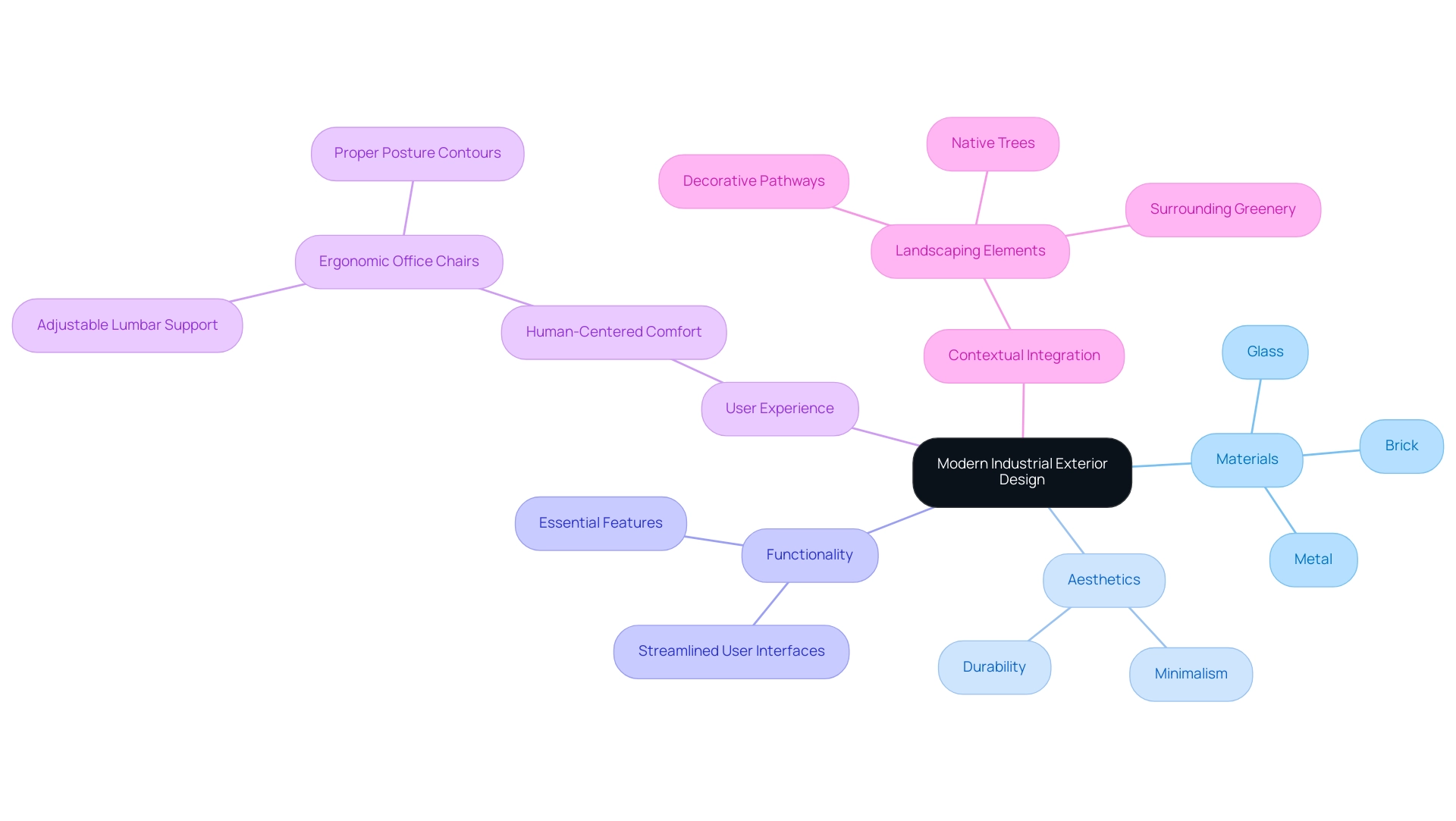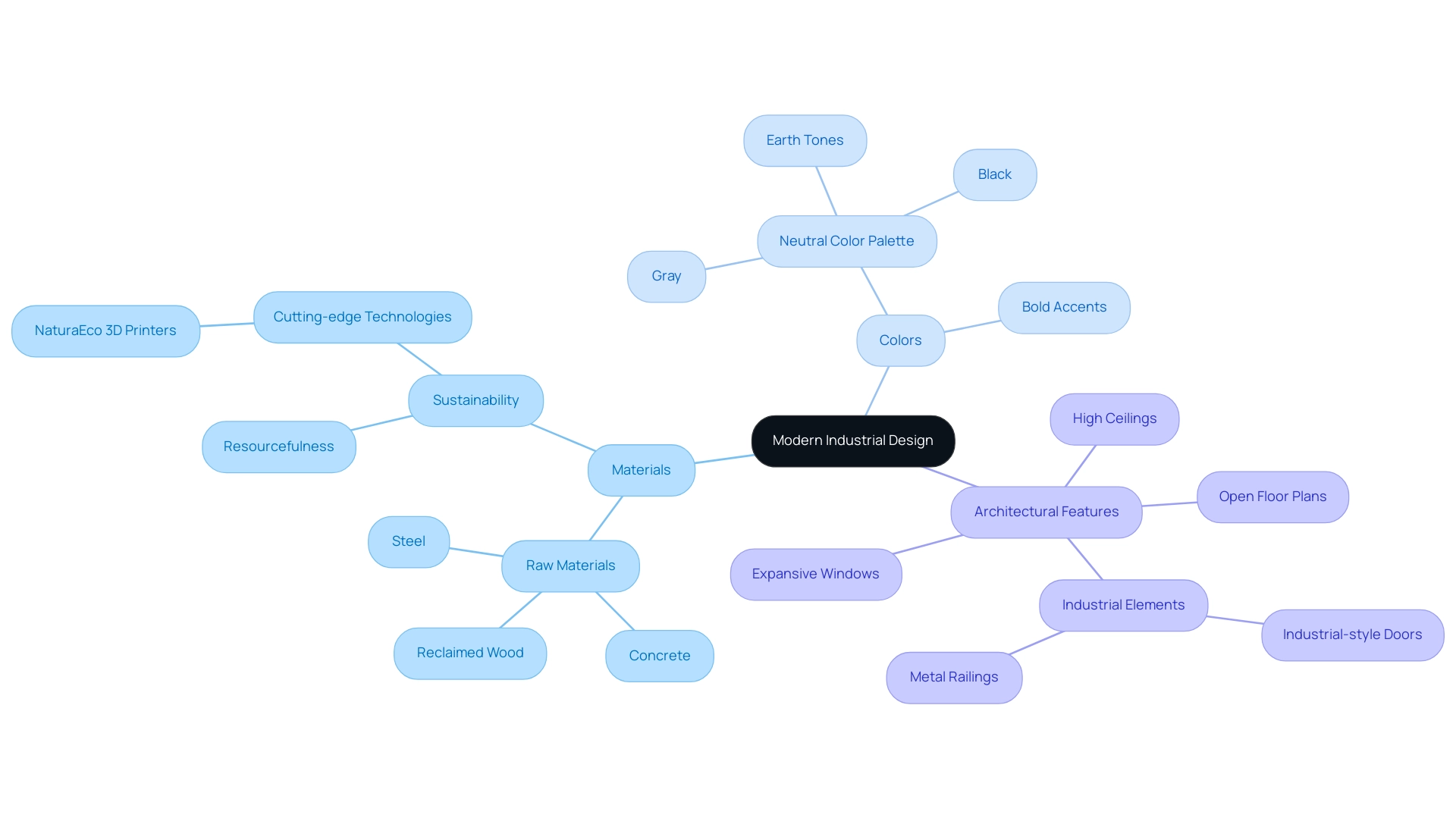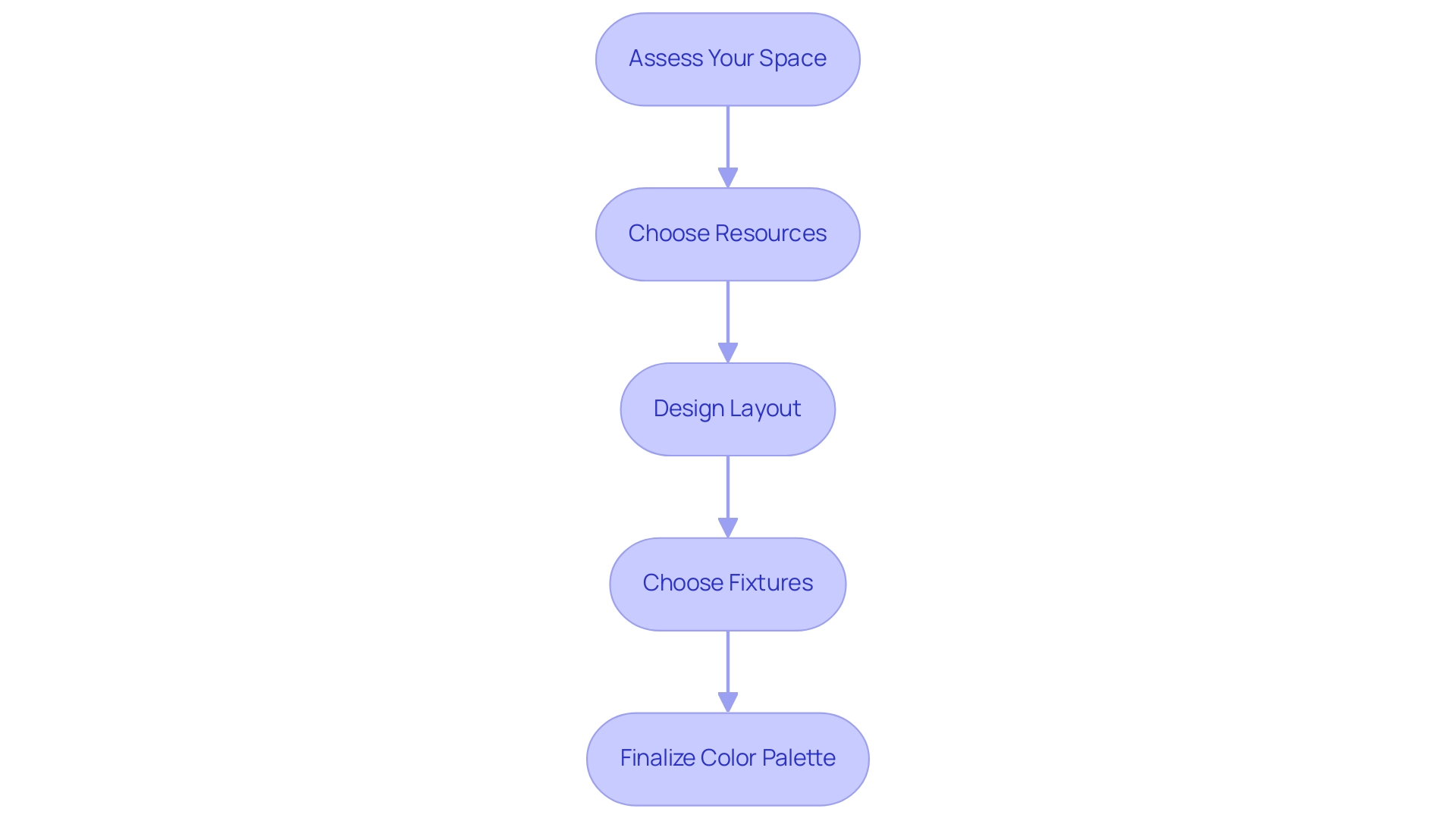Introduction
In the realm of architectural innovation, modern industrial exterior design stands out as a compelling synthesis of form, function, and context. This design philosophy is characterized by an intentional blend of raw materials, expansive spaces, and utilitarian aesthetics, which together create an environment that is both visually striking and deeply integrated with its surroundings.
As the industry evolves, the principles of minimalism and sustainability take center stage, influencing everything from material selection to the incorporation of natural elements.
With a significant number of business leaders acknowledging the critical role of thoughtful design in their success, the importance of precise architectural choices becomes increasingly evident.
This article delves into the essential elements of modern industrial design, offering a comprehensive guide to implementing these concepts effectively while highlighting the transformative power of exterior renderings in shaping architectural narratives.
Understanding Modern Industrial Exterior Design
Modern industrial exterior design epitomizes a harmonious fusion of raw materials, expansive spaces, and utilitarian forms, showcasing how exterior renderings play a pivotal role in architectural visualization. This design showcases a modern industrial exterior with exposed brick, steel beams, and large windows that maximize natural light, creating an inviting atmosphere while demonstrating the building’s contextual integration with its environment. The roots of this style trace back to the adaptive reuse of warehouses and factories, which exemplifies modern industrial exterior design by championing a minimalist approach that prioritizes function over decorative elements.
In 2024, the focus on minimalist aesthetics continues to shape product functionality, streamlining user interfaces and enhancing essential features. Notably, 49% of startup and business owners acknowledge aesthetics as ‘very important’ to their success, underscoring the significance of thoughtful architectural choices. The impact of detailed renderings of modern industrial exterior design extends beyond aesthetics; they serve as a critical tool in pre-sales visualization, empowering developers to generate interest and investment long before the physical manifestation of the project.
Moreover, a remarkable statistic shows that 54% of graphic designers depart or switch positions in less than 2 years, underscoring the significance of creativity in retaining talent within the industry. A focus on human-centered comfort in creation has led to innovations such as ergonomic office chairs, which embody manufacturing principles by accommodating the natural movements and limitations of the human body, featuring adjustable lumbar support and contours for proper posture. Additionally, incorporating landscaping elements such as native trees, decorative pathways, and surrounding greenery enhances the visual appeal and integration of the building within its environment.
The durability and aesthetic appeal of materials like glass and metal are also crucial, as they not only contribute to the building’s visual impact but also ensure long-lasting performance. Such advancements demonstrate the changing environment of manufacturing aesthetics, where each component is carefully arranged to embody the ethos of modern industrial exterior design. By understanding these principles and leveraging the power of exterior renderings, architects can create concepts that not only resonate aesthetically but also foster meaningful connections between businesses and users.
Key Elements of Modern Industrial Design
The essence of modern industrial design is rooted in several key elements that define its character and functionality:
Materials: The use of raw materials, including concrete, steel, and reclaimed wood, is pivotal in establishing an authentic industrial aesthetic. These resources not only enhance the visual appeal but also highlight sustainability and resourcefulness, aligning with contemporary architectural values. The integration of cutting-edge technologies, like those created by Serbian startup NaturaEco, demonstrates how multifunctional construction techniques can improve the application of these resources, converting intricate digital blueprints into physical structures. Furthermore, this process is enhanced during development through detailed 3D visualizations, allowing architects to experiment with alterations and material selections, ensuring client satisfaction and enabling early identification of potential issues.
Colors: A predominantly neutral color palette, characterized by shades of gray, black, and earth tones, is prevalent in industrial styles. This approach creates a cohesive look, with approximately 80% of styles embracing these colors, as noted in industry trends. Bold accents may be introduced to provide contrast and vibrancy, enhancing the overall ambiance of the space. The use of 3D visualizations during this phase also helps clients understand the color schemes better, facilitating improved communication among stakeholders and identifying issues early in the process.
Architectural Features: High ceilings, open floor plans, and expansive windows are hallmarks of modern industrial exterior design. These features promote a feeling of spaciousness and airiness, while elements such as metal railings and industrial-style doors further enhance the character of the structure. The integration of advanced construction techniques, like those from NaturaEco, not only enhances efficiency and flexibility but also promotes sustainability, addressing the increasing demand for innovative architectural solutions that embrace modern industrial exterior design in the contemporary landscape. Development plays a crucial role here, as it allows architects to create detailed visualizations that enhance stakeholder engagement and ensure the concept aligns with the client’s vision. For instance, when experimenting with an open floor plan, architects can use 3D visualizations to evaluate how different layouts affect space utilization and aesthetics, allowing for informed decision-making.
In the words of creator Grace Lim, “Enamor, by creator Grace Lim, provides users with only one arm the opportunity to expand their cooking skills by making…” This emphasizes the significance of inclusive creation in contemporary architecture, ensuring that functionality meets the needs of diverse users.
Step-by-Step Guide to Implementing Industrial Design
Assess Your Space: Conduct a thorough evaluation of the existing architecture and landscape. Identify key elements that can be preserved or enhanced to maintain the integrity of the structure. This evaluation should encompass considerations of natural light, views, and structural features that can serve as focal points in the layout. According to information gathered from 653 students, understanding the existing space significantly influences the overall effectiveness. High-quality renderings during this phase allow for a clearer visualization of potential enhancements, illustrating how textures and light interplay can evoke specific emotions and foster collaborative discussions with clients to refine the vision.
Choose Resources: Opt for substances that reflect the aesthetic of modern industrial exterior design while also aligning with the emotional and lifestyle requirements of the inhabitants. Concrete serves as an excellent choice for pathways due to its durability, while metal can be effectively utilized for railings. Incorporating reclaimed wood for accents adds warmth and supports sustainable practices in creation. As pointed out by Anand M. Joglekar, “By assisting readers in fully utilizing statistical methods to enhance industrial performance, this book serves as an excellent reference and self-study resource for scientists, engineers, managers, and other technical experts across a broad spectrum of industries,” highlighting the significance of informed selection. Employing detailed renderings can also aid in visualizing how these materials will interact in the final composition, enhancing the understanding of their textures and the overall aesthetic.
Design Layout: Strategically plan the layout to maximize open spaces and encourage the flow of natural light. The layout should facilitate seamless transitions between indoor and outdoor areas, promoting an environment conducive to collaboration and creativity. The selection of layout elements should be guided by the characteristics of the measurement system, ensuring that the design meets functional requirements. Engaging clients with visual representations of layout options will enhance feedback and alignment with their vision, allowing them to feel emotionally connected to the space.
Choose Fixtures: Carefully select fixtures that are in harmony with the industrial theme and reflect the desired emotional tone of the space. Metal light fixtures and minimalist furniture are ideal choices that enhance the overall aesthetic without overwhelming the space. The selection of fixtures should also represent the characteristics of the overall layout and measurement systems in place for a modern industrial exterior design. Visualization tools can illustrate how various fixtures will enhance the overall layout, aiding in decision-making and ensuring that the emotional resonance is maintained.
Finalize Color Palette: Establish a color scheme that complements the selected components and overall vision. Focus on neutral tones that provide a versatile backdrop while allowing for the introduction of potential accent colors to add character and vibrancy to the space. Integrating these color choices with the selected materials and layout will ensure a cohesive design. High-quality renderings are essential in this phase to visualize the impact of color selections and ensure they align with the desired style, enhancing the emotional connection to the space.
Choosing the Right Lighting for Industrial Exteriors
When choosing illumination for commercial exteriors, it is essential to embrace a thorough method that integrates practicality with visual attractiveness. Consider the following elements:
Types of Lighting: A well-designed lighting scheme should incorporate a blend of ambient, task, and accent lighting. This combination not only guarantees practical lighting but also enhances depth and visual appeal in the area, addressing both functional requirements and design preferences.
Fixture Styles: The selection of fixtures should match the structural theme of the building. Choose styles made from sturdy substances like metal, which align with modern industrial exterior design principles. Pendant lights and wall sconces that showcase modern industrial exterior design elements are especially effective in establishing a unified appearance.
Placement: Strategic positioning of lighting fixtures is crucial for emphasizing architectural features and directing pathways. This not only enhances safety but also elevates the visual appeal of the exterior environment after dark. Incorporating LED lights is advisable, as they offer superior energy efficiency and longevity, which aligns with the sustainability goals of modern industrial exterior design. For example, the TL100VS has a typical flow rate of 40 gpm, highlighting the progress in energy-efficient lighting options.
As we move towards 2024, the trends in commercial lighting aesthetics keep evolving, emphasizing innovative fixtures and energy-efficient alternatives. Notable companies in this sector, such as Syska LED Lights Company and Hubbell Incorporated, are leading the way, showcasing the latest advancements in lighting technology. As noted by industry experts,
When technical issues arise, consult experts, foster team collaboration, and invest in training to solve problems efficiently and prepare for the future.
This philosophy emphasizes the importance of incorporating expert perspectives into the creation process to navigate the complexities of contemporary lighting effectively, ensuring that architects are well-equipped to develop functional and visually appealing spaces that reflect modern industrial exterior design.
Incorporating Landscaping into Industrial Exterior Design
To effectively incorporate landscaping into commercial exterior design, consider the following strategies:
Choose Appropriate Plants: Opt for resilient plants that thrive in challenging environments and require minimal upkeep, such as succulents and ornamental grasses. These selections not only enhance the aesthetic appeal but also align with the modern industrial exterior design, creating a harmonious blend of nature and structure. Significantly, larger invoice amounts enable landscaping firms to charge higher fees for these specialized services, reflecting the financial implications of careful plant selection in commercial environments.
Create Defined Spaces: Implement planters crafted from concrete or metal to establish distinct garden areas. This approach reinforces the design’s modern industrial exterior design while providing a clear structure to the landscape. A case study on regional plant preferences in Colorado highlights how new clients often seek traditional and structured plant options, which can sometimes conflict with local ecological practices. Understanding these preferences is crucial for aligning landscaping with regional needs.
Integrate Hardscaping: Incorporate functional outdoor spaces through walkways and patios made from materials such as stone or reclaimed wood. These elements not only improve usability but also align with the principles of modern industrial exterior design. Additionally, consider adding seating areas furnished with industrial-style furniture, which fosters a connection between the landscape and its users. Moreover, the increase of automated lawn mowers in commercial landscaping illustrates a current trend that can significantly lower labor expenses while upholding aesthetic standards in design.
As Clay Tully, a landscape architect, aptly notes,
It brings a greater connection to the land and the people you share with.
This connection is essential in creating areas that are both functional and visually appealing, reflecting contemporary landscaping trends in 2024.
Final Touches and Considerations
To attain a successful contemporary exterior, consider the following strategies:
Incorporate Artwork: Integrating sculptures or art pieces crafted from metal or reclaimed materials can significantly enhance the theme of your project. As mentioned by Rebecca Murdock, designs can draw inspiration from various cultural movements, including the Riot Grrrl movement, which emphasizes raw, impactful visuals. Such artwork not only provides visual appeal but also conveys a narrative that resonates with the essence of design.
Embrace Diverse Textures: Utilizing a range of textures is essential in creating a visually engaging outdoor space. Materials such as rough stone, smooth metal, and soft fabrics in outdoor furniture can complement one another, offering a dynamic contrast that enriches the overall aesthetic. Present trends emphasize the significance of texture in outdoor manufacturing furniture, where tactile contrasts play an essential role in aesthetic attraction.
Ensure Cohesion: Cohesion is key in contemporary manufacturing. Each element—ranging from building materials to landscaping choices—should work harmoniously to create a unified look. Frequently reviewing the layout permits essential modifications and guarantees the integrity of the aesthetic is upheld throughout the project.
As David Bowie famously stated, ‘I know when to go out, I know when to stay in, and get things done,’ which can serve as a reminder of the balance needed in the creative process. Additionally, contemplating Murdock’s case study titled ‘Understanding Failure,’ in which she explores the significance of accountability and personal development, can offer valuable insights for architects traversing the challenges of contemporary creation. With more than 60 institutions in the United States providing programs in applied arts, there is an expanding base of knowledge and interest in these trends.
Incorporating these elements will not only elevate your design but also contribute to creating a space that reflects modern industrial exterior design principles.
Conclusion
Modern industrial exterior design encapsulates a powerful blend of raw materials, functional aesthetics, and contextual harmony, establishing a framework that resonates with both contemporary architectural values and user needs. The emphasis on minimalism and sustainability is evident through the strategic selection of materials, colors, and architectural features that not only enhance visual appeal but also promote environmental responsibility. As highlighted, the role of detailed exterior renderings is paramount, serving as a vital tool for architects to visualize and communicate their design intentions effectively.
Implementing modern industrial design principles involves a systematic approach that begins with a thorough assessment of existing spaces, followed by careful material selection and thoughtful layout planning. Each decision made—from fixture choices to color palettes—contributes to an overarching narrative that connects the built environment with its users and surroundings. The integration of landscaping and lighting further enriches this narrative, ensuring that the design is not only functional but also aesthetically captivating.
Ultimately, the transformative power of modern industrial design lies in its ability to create spaces that foster connection, innovation, and sustainability. As the industry continues to evolve, architects are called upon to embrace these principles, leveraging their expertise to craft environments that reflect a harmonious relationship between structure and nature. By doing so, they not only elevate the aesthetic quality of their projects but also contribute to a more sustainable and engaging architectural landscape.







0 Comments